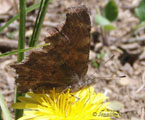Native Plants
Search for native plants by scientific name, common name or family. If you are not sure what you are looking for, try the Combination Search or our Recommended Species lists.
Salix humilis
Salix humilis Marshall
Prairie Willow
Salicaceae (Willow Family)
Synonym(s):
USDA Symbol: SAHU2
USDA Native Status: L48 (N), CAN (N)
Mounded shrub, 6-10 ft. tall, which often forms thickets. Ascending, wand-like branches are yellowish to brown. Gray-green to blue-green foliage has insignificant fall color. Greenish catkins appear before leaves emerge.
Plant Characteristics
Duration: PerennialHabit: Shrub
Leaf Retention: Deciduous
Leaf Arrangement: Alternate
Leaf Complexity: Simple
Fruit Type: Capsule
Size Notes: Up to about 10 feet tall.
Leaf: Dark Green
Autumn Foliage: yes
Fruit: Brown
Bloom Information
Bloom Color: White , Yellow , Green , Purple , BrownBloom Time: Jan , Feb , Mar , Apr , May , Jun
Distribution
USA: AL , AR , CT , DC , DE , FL , GA , IA , IL , IN , KS , KY , LA , MA , MD , ME , MI , MN , MO , MS , NC , ND , NE , NH , NJ , NY , OH , OK , PA , RI , SC , SD , TN , TX , VA , VT , WI , WVCanada: NB , NS , ON , PE , QC
Native Distribution: Nf. to MN & Man., s. to VA, MO & e. KS; local to FL & e. TX
Native Habitat: Alluvial areas; boggy openings in pine woods; low areas in prairies; dry barrens; balds
Growing Conditions
Water Use: HighLight Requirement: Sun
Soil Moisture: Dry , Wet
Soil pH: Circumneutral (pH 6.8-7.2)
CaCO3 Tolerance: Medium
Soil Description: Various wet to dry soils.
Conditions Comments: Short-lived and fast-growing. Susceptible to wind damage.
Benefit
Use Wildlife: Early season harvest for birds and mammals.Attracts: Birds
Value to Beneficial Insects
Special Value to Native BeesSupports Conservation Biological Control
This information was provided by the Pollinator Program at The Xerces Society for Invertebrate Conservation.
Butterflies and Moths of North America (BAMONA)
|
Green Comma (Polygonia faunus)  Larval Host |
Propagation
Description: Willows are among the easiest of all plants to root from cuttings. Stem and root cuttings are used. Propagation is also accomplished by sowing fresh, untreated seed into a moist seedbed.Commercially Avail: yes
National Wetland Indicator Status
| Region: | AGCP | AK | AW | CB | EMP | GP | HI | MW | NCNE | WMVE |
| Status: | FACU | FACU | FACU | FACU | FACU |
From the National Organizations Directory
According to the species list provided by Affiliate Organizations, this plant is on display at the following locations:Mt. Cuba Center - Hockessin, DE
Bibliography
Bibref 1186 - Field Guide to Moths of Eastern North America (2005) Covell, C.V., Jr.Bibref 1185 - Field Guide to Western Butterflies (Peterson Field Guides) (1999) Opler, P.A. and A.B. Wright
Search More Titles in Bibliography
Web Reference
Webref 38 - Flora of North America (2019) Missouri Botanical Garden, St. Louis, MO & Harvard University Herbaria, Cambridge, MA.Webref 23 - Southwest Environmental Information Network (2009) SEINet - Arizona Chapter
Additional resources
USDA: Find Salix humilis in USDA PlantsFNA: Find Salix humilis in the Flora of North America (if available)
Google: Search Google for Salix humilis
Metadata
Record Modified: 2022-10-21Research By: TWC Staff